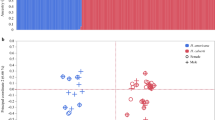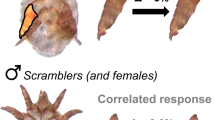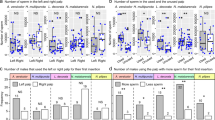Abstract
In coevolutionary ‘arms races’ between the sexes, the outcome of antagonistic interactions may remain at an evolutionary standstill. The advantage gained by one sex, with any evolutionary exaggeration of arms, is expected to be matched by analogous counteradaptations in the other sex1,2. This fundamental coevolutionary process may thus be hidden from the evolutionist's eye3,4, and no natural examples are known. We have studied the effects of male and female armament (clasping and anti-clasping morphologies) on the outcome of antagonistic mating interactions in 15 species of water strider, using a combination of experimental and phylogenetic comparative methods. Here we present, by assessing the independent effects of both species-specific level of arms escalation and small imbalances in the amounts of arms between the sexes within species, the consequences of a sexual arms race. Evolutionary change in the balance of armament between males and females, but not in the species-specific level of escalation, has resulted in evolutionary change in the outcome of sexually antagonistic interactions such as mating rate.
This is a preview of subscription content, access via your institution
Access options
Subscribe to this journal
Receive 51 print issues and online access
$199.00 per year
only $3.90 per issue
Buy this article
- Purchase on Springer Link
- Instant access to full article PDF
Prices may be subject to local taxes which are calculated during checkout

Similar content being viewed by others
References
Chapman, T. & Partridge, L. Sexual conflict as fuel for evolution. Nature 381, 189–190 (1996).
Rice, W. R. Sexually antagonistic male adaptation triggered by experimental arrest of female evolution. Nature 381, 232–234 (1996).
Rice, W. R. Dangerous liaisons. Proc. Natl Acad. Sci. USA 97, 12953–12955 (2000).
Partridge, L. & Hurst, L. D. Sex and conflict. Science 281, 2003–2008 (1998).
Gavrilets, S., Arnqvist, G. & Friberg, U. The evolution of female mate choice by sexual conflict. Proc. R. Soc. Lond. B 268, 531–539 (2001).
Civetta, A. & Clark, A. G. Correlated effects of sperm competition and postmating female mortality. Proc. Natl Acad. Sci. USA 97, 13162–13165 (2000).
Gavrilets, S. Rapid evolution of reproductive barriers driven by sexual conflict. Nature 403, 886–889 (2000).
Swanson, W. J., Yang, Z., Wolfner, M. F. & Aquadro, C. F. Positive Darwinian selection drives the evolution of several female reproductive proteins in mammals. Proc. Natl Acad. Sci. USA 98, 2509–2514 (2001).
Arnqvist, G. Comparative evidence for the evolution of genitalia by sexual selection. Nature 393, 784–786 (1998).
Rice, W. R. in Endless Forms—Species and Speciation (eds Howard, D. J. & Berlocher, S. H.) 261–270 (Oxford Univ. Press, Oxford, 1998).
Parker, G. A. & Partridge, L. Sexual conflict and speciation. Phil. Trans. R. Soc. Lond. B 353, 261–274 (1998).
Arnqvist, G., Edvardsson, M., Friberg, U. & Nilsson, T. Sexual conflict promotes speciation in insects. Proc. Natl Acad. Sci. USA 97, 10460–10464 (2000).
Parker, G. A. in Sexual Selection and Reproductive Competition in Insects (eds Blum, M. S. & Blum, N. A.) 123–163 (Academic, New York, 1979).
Parker, G. A. Arms races in evolution—an ESS to the opponent-independent cost game. J. Theor. Biol. 101, 619–648 (1983).
Härdling, R. Arms races, conflict costs and evolutionary dynamics. J. Theor. Biol. 196, 163–167 (1999).
Harvey, P. H. & Pagel, M. D. The Comparative Method in Evolutionary Biology (Oxford Univ. Press, Oxford, 1991).
Garland, T., Harvey, P. H. & Ives, A. R. Procedures for the analysis of comparative data using phylogenetically independent contrasts. Syst. Biol. 41, 18–32 (1992).
Rowe, L., Arnqvist, G., Sih, A. & Krupa, J. J. Sexual conflict and the evolutionary ecology of mating patterns: water striders as a model system. Trends Ecol. Evol. 9, 289–293 (1994).
Arnqvist, G. in The Evolution of Mating Systems in Insects and Arachnids (eds Choe, J. C. & Crespi, B. J.) 146–163 (Cambridge Univ. Press, Cambridge, 1997).
Arnqvist, G. & Rowe, L. Correlated evolution of male and female morphologies in water striders. Evolution (in the press).
Arnqvist, G. Sexual selection in water strider: the function, nature of selection and heritability of a male grasping apparatus. Oikos 56, 344–350 (1989).
Arnqvist, G. & Rowe, L. Sexual conflict and arms races between the sexes: a morphological adaptation for control of mating in a female insect. Proc. R. Soc. Lond. B 261, 123–127 (1995).
Losos, J. B. Uncertainty in the reconstruction of ancestral character states and limitations on the use of phylogenetic comparative methods. Anim. Behav. 58, 1319–1324 (1999).
Gittleman, J. L. & Kot, M. Adaptation—statistics and a null model for estimating phylogenetic effects. Syst. Zool. 39, 227–241 (1990).
Rowe, L. 1994. The costs of mating and mate choice in water striders. Anim. Behav. 48, 1049–1056 (1994).
Watson, P. J., Arnqvist, G. & Stallman, R. R. Sexual conflict and the energetic costs of mating and mate choice in water striders. Am. Nat. 151, 46–58 (1998).
Felsenstein, J. The Phylogeny Inference Package [online]. 〈http://evolution.genetics.washington.edu/phylip.html〉 (2001).
Damgaard, J. & Sperling, F. A. H. Phylogeny of the water strider genus Gerris Fabricius (Heteroptera : Gerridae) based on COI mtDNA, EF-1α nuclear DNA and morphology. Syst. Entomol. 26, 241–254 (2001).
Rohlf, F. J. & Corti, M. Use of two-block partial least-squares to study covariation in shape. Syst. Biol. 49, 740–753 (2000).
Rowe, L. & Arnqvist, G. Sexually antagonistic coevolution in a mating system: combining comparative and experimental approaches to address evolutionary process. Evolution (in the press).
Acknowledgements
This study was supported by the Swedish Natural Science Research Council, the Natural Sciences and Engineering Research Council of Canada, the Swedish Foundation for International Cooperation in Research and Higher Education, the Knut and Alice Wallenberg Foundation and the Magnus Bergvalls Stiftelse. We thank N. M. Andersen and J. Damgaard for phylogenetic information; J. Felsenstein and F. J. Rohlf for developing software; and T. Day, U. Friberg, D. Schluter and T. Tregenza for comments.
Author information
Authors and Affiliations
Corresponding author
Ethics declarations
Competing interests
The authors declare no competing financial interests.
Supplementary information
Rights and permissions
About this article
Cite this article
Arnqvist, G., Rowe, L. Antagonistic coevolution between the sexes in a group of insects. Nature 415, 787–789 (2002). https://doi.org/10.1038/415787a
Received:
Accepted:
Issue Date:
DOI: https://doi.org/10.1038/415787a
This article is cited by
-
Convergent evolution and convergent loss in the grasping structures of immature earwigs and aphidlion-like larvae as demonstrated by about 100-million-year-old fossils
Swiss Journal of Palaeontology (2023)
-
Homme fatal: how males cause demise
Nature Aging (2022)
-
Evolution of reduced mate harming tendency of males in Drosophila melanogaster populations selected for faster life history
Behavioral Ecology and Sociobiology (2022)
-
Conflict and the evolution of viviparity in vertebrates
Behavioral Ecology and Sociobiology (2022)
-
Sexual conflict drives micro- and macroevolution of sexual dimorphism in immunity
BMC Biology (2021)
Comments
By submitting a comment you agree to abide by our Terms and Community Guidelines. If you find something abusive or that does not comply with our terms or guidelines please flag it as inappropriate.



